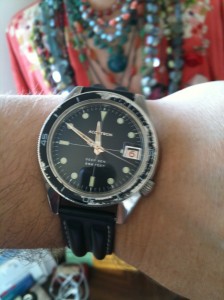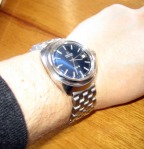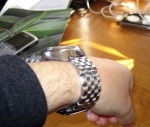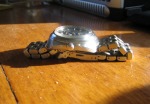Another big 1970s watch: a Seiko 6138-0011 ‘UFO’ automatic chronograph from 1976. The face is a little worn — especially around the chrono subdials — but the case, hands, bezel and crystal are in great shape; it goes and goes and keeps excellent time; and the red-and-black perforated leather strap I found is a perfect match.
Bulova Accutron 218 Deep Sea (1968)
August 20, 2009This one is my first ‘hummer’ — an Accutron. It has a battery, but unlike a quartz watch, the charge from the battery ‘excites’ a tuning fork to oscillate at a constant frequency. Hence the watch ‘hums’ rather than ticks. Very cool technology for 1960. And unlike a quartz watch, the second hand sweeps smoothly rather than in one-second jerks.
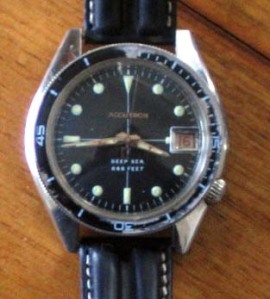
1968 Bulova Accutron 218 Deep Sea
This Accutron was made in 1968 (it has an ‘M8’ date code on the back). It uses the 218 calibre movement, the second iteration of the Accutron following on from the 214.
When new it was a professional diving watch, waterproof to 666 feet — but nowadays I’d be reluctant to get it wet until I have the seals replaced and the case pressure-tested.
The case and dial are in very good condition but the bezel is showing its age, as are the hands. I love the red-on-silver date and the domed crystal with cyclops magnifier *under* the uninterrupted curve (why didn’t Rolex think of that?)
Certina DS-3
August 20, 2009This is one of my more recent purchases from eBay. It’s an early 1970s Certina DS-3. From what I’ve been able to find out so far, it’s quite rare — Certina made some very chunky dive watches with a similar case, including the DS-3 Super PH, of which some were issued to the Royal Australian Navy. But I haven’t seen many other dress watches using this big cushion case.
Unsurprisingly it’s heavy, even more so on the Watchadoo ‘lumpy’ bracelet. But it is comfortable, with the case curved on the sides so it sits snugly on the wrist.
It has a slightly sparkly metallic blue face with silver baton markers, and slight traces of lume left. The movement is a Certina house automatic, c. 919 (which I think might be based on an A. Schild movement). It runs very well on the wrist, but doesn’t have a lot of life when unworn, so it may need a service soon.
It is also completely silent — the Certina ‘double-shock’ insulation is so effective in isolating the movement from the case that you can’t hear it tick even when it’s right against your ear (either that or I’m going deaf!).
And all this for under A$200!
Poljot Sturmanskie. It’s Russian, da?
August 12, 2009
this is my Poljot Sturmanskie from the 1990s
This is a bit of a test-post. The somewhat blurry photo to the left shows my Poljot Sturmanskie chronograph. It’s Russian (indeed it says ‘made in CCCP’ under the right-hand subdial), dates from about the 1990s, and is powered by the Poljot 3133 manual-wind movement. It’s a chunky watch, with a squared-off pillow case, a little reminiscent of the Heuer Monza. It’s very accurate, but the chrono does sometimes stop the watch, indicating it’s probably time I got it serviced. Currently on a blue canvas strap from Eddie at Timefactors, which is an almost perfect colour-match for the blue dial. This particular watch isn’t an issued military watch: although this model was used by both the Soviet airforce and navy, I suspect this one dates from the ‘Perestroika’ era when previously Soviet companies began to open up and sell their products to civilians, and even to foreigners!
Hello world!
August 12, 2009I’ve decided to teach myself how to use WordPress by creating a blog about one of my little obsessions — collecting interesting (usually) vintage watches.







 Posted by timswatches
Posted by timswatches 